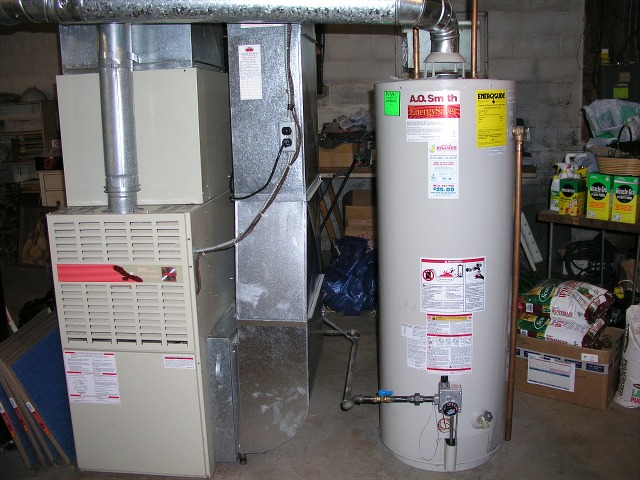
We could have a problem here!
Potential problems arise in respect to the mutual understanding of the parties and the manner in which the rental issue is documented.
The Furnace Rental
The leasing of furnaces by the furnace supply industry is a relatively recent phenomena. Until recently, it was just hot water heaters that were rented. However, they were modest in value.
Furnaces can easily cost about $6,000.00 installed in the average residential environment. That’s a lot of money for someone who has just had their older furnace “red-tagged” by the furnace maintenance company.
When a furnace is “red-tagged”, it will be immediately shut down, and it cannot be used at all. This comes as a shock and surprise in January.
The homeowner thought he had a maintenance contract that included necessary repairs. He did, but now he needs a whole new furnace. Before we leave this point: get a second opinion!
The problem is that we have sub-zero temperatures in January and the homeowner doesn’t have $6,000.00 for a new furnace. Well, that’s no problem, the furnace finance company will come to the rescue. It will lease the new furnace to the homeowner. The good news is that maintenance will be included. The bad news is that the leasing contract will go on forever (Ok, not quite forever, but it will seem that way).
The homeowner will qualify for a reduced rate, zero interest deal. But, the price of the furnace will be grossed up in the transaction. So, monthly payments, over ten years; but the value of the furnace will show at $10,000.
What does this really mean?
120 equal payments of $83.33 per month for 10 years.
The bottom line, is that the homeowner will have to pay $10,000.00 to get title to this furnace.
So, day one, buy it outright for $6,000.00. Day two, if you leased it, pay $10,000.00 to buy out the contract. This is NOT CHEAP.
And, you thought $83.33 per month sounded affordable, particularly with zero interest.
Don’t forget, the furnace maintenance company, the furnace supply company and the furnace finance company are all the same!
Chattel or Fixture?
The case law on this point is quite clear. The furnace will be a fixture, unless it happens to sit in a museum as a non-working model.
The purpose of the furnace is to heat the house. That’s for the benefit of the house and that makes it a fixture. Real property law prevails over any private contracts or agreements in terms of the characterization of the furnace.
The Real Estate Transaction
Let’s assume that the homeowner tells his agent when he lists his property that the furnace is a rental. The payments are $83.33 and the contract runs for 10 years.
This is all well and good, but doesn’t the Furnace Finance Company have a say in this? Why would they want to approve the new buyer? Why would they want the new buyer to take over the contract?
If you look at their contract closely, you are likely to find an acceleration clause, not an assumption clause. That means, if there is a change in ownership, then the whole amount outstanding is immediately due and payable. Yes, that means the homeowner would have to pay off the $10,000.00 (or lesser outstanding balance) in order to get title to the furnace.
It’s not a good result, but, that’s the way it works!
Documenting the Deal
There are two provisions in the agreement which are relevant, namely, Fixtures and Rental Items.
Agreement of Purchase and Sale (Fixtures Excluded)
In an agreement of purchase and sale there are often some fixtures that are to be excluded from the transaction.
There are two kinds of items that you will find itemized: chattels and fixtures. Chattels are separate, independent items of personal property. Fixtures are items that are so affixed, attached or annexed to the real estate, that they are in law considered to be part of the real property.
So, the law is clear, “say nothing” and:
• Fixtures go with the property,
• Chattels remain with the owner.
Let’s have a look at the standard form agreement of purchase and sale and see what it says in the “fixtures excluded” clause:
“5. FIXTURES EXCLUDED:.______________________________________________________________________________________________________________”
The legal definitions of chattels and fixtures sometimes give rise to incorrect interpretations. Consequently, in this standard form, the draftsman has decided that it would be better to list the fixtures which are to be excluded from the deal rather than recite the legal rules.
This makes good sense. It’s not necessary to engage in debate. If there are fixtures that are to be excluded, then list them, and use an extra schedule if necessary. You might even err on the side of making reference to a chattel in the fixtures excluded category in order to add greater certainty to the intention of the parties. Unfortunately, that happens a lot, leading to more confusion going forward.
These lists are a common way of doing business. As a by-product, they also add confusion to the matter of interpretation. A buyer will include a “built-in dishwasher” which is a fixture, and list it as a “chattel included”.
That makes some people think that it is a chattel when truly it’s not. And, naturally other examples add further confusion.
Electric light fixtures are “fixtures”. They go with the property unless they are specifically mentioned as a “fixture excluded”. Frequently, a seller may wish to retain the dining room chandelier because it’s really more like “personal property”. Courts look to the intention associated with the attachment in order to determine whether annexation has occurred in law. This leaves out the dinning room light fixture in some cases. So, it’s always best to mention it, for clarity.
Remember to itemize anything which is to be removed, and just because it’s not attached doesn’t mean it’s not a fixture. The hose to the central vacuum system is a fixture and it stays with the house.
Fixtures and Chattels often give rise to controversy. The list is a simple, straightforward method to avoid conflict. Be sure to use it.
Agreement of Purchase and Sale (Rental Items)
In an agreement of purchase and sale there are often some fixtures that are to be excluded from the transaction. These are not the ones that are excluded by choice because the owner wants to take them; these are the ones that are “rented”, and the owner would like the new purchaser to take them over.
Let’s have a look at the standard form agreement of purchase and sale and see what it says in the “rental items” clause:
“6. RENTAL ITEMS: The following equipment is rented and not included in the Purchase Price. The Buyer agrees to assume the rental contract(s), if assumable:
_________________________________________________________________________________________________________________________”
Alarm systems and hot water tanks are often rented. Furnaces and air conditioners may be rented. This needs to be determined at the outset by the listing brokerage.
The intention, of course, is that these items are to stay with the property and be included as part of the transaction. It is probably the intention of the seller,that the buyer simply takes over the continuing payments in the rental agreement. However, the agreement may not be “assumable”. It may include an acceleration clause. The buyer may expect, on the other hand, that these items were fully paid for, and owned by the seller.
Now, we have a significant dispute.
If the item is a fixture, then it’s included unless it’s on the excluded list. For greater certainty, and to avoid any confusion, the hot water tank, the alarm system, and the furnace (assuming that they are rental items) should appear first in the “fixtures excluded” list. Then, they should be mentioned once again in the “rental items” list.
You will notice that under rental items, the distinction between chattels and fixtures is not made. Everything is simply referred to as “equipment”. This is fine as long as the equipment might be considered to be a chattel. But, there is a potential problem if it happens to be a fixture, because fixtures are part of the real estate. And, clearly, the furnace is a fixture.
Most registrants will only mention them once. As long as the seller and the buyer get along and the deal closes, then this is not likely to cause dispute, but if the parties decide to sue one another, then this is just more “fuel for the fire”.
If the hot water tank, alarm system and furnace are overlooked, and they are rental items, then the buyer may be entitled to have the seller “buy out” the contract.
If they can’t be assumed, then the owner of this equipment may insist that the contact be bought out, and the seller will have to pay. Often, the seller will turn to the agent for reimbursement.
The Options
The options for the rental furnace seem obvious.
1) Buy Out, or
2) Assumption.
Buy Out
This is the option of choice for the buyer. Here, the seller is to pay it off and convey title.
The documentation should reflect that it is a fixture. But, there’s only one category, and that is for “excluded fixtures” and it’s not excluded. So, you can be silent here in paragraph 5.
When it comes to paragraph 6, it is indeed a “rental item”. However, it is to be paid off and conveyed. So, disclose it, because it’s still subject to payments. Amend the wording as follows:
“The following equipment is rented and not included in the Purchase Price. The Buyer agrees to assume the rental contract(s), if assumable:”
Be sure to delete the words in bold.
That clause will now read as follows:
“The following equipment is rented and included in the Purchase Price.”
Assumption of the Furnace Rental Contract
Let’s assume that the furnace is rented and the contract is to be assumed by the buyer.
The appropriate clause should read as follows:
“The following equipment is rented and not included in the Purchase Price. The Buyer agrees to assume the rental contract(s), and will pay any assumption fees, if required:”
You will notice that we added the issue of fees. That matter should not be left to chance. In many cases, there are fees, and it should not be left “up in the air”. The agreement should specify who is to pay.
Quasi-Assumption: This time, the seller finds out that he has to pay out the furnace leasing contract. But, rather than a gift to the buyer, why not have the buyer continue to make the regular $83.33 monthly payments to the seller. From the buyer’s perspective, that was what he expected in the first place. While the seller was caught off guard with the acceleration clause, he just paid out $10,000.00, so this is a way to get some of that money back over time. Better than nothing!
COMMENT
There is a clear opportunity to avoid confusion about what stays and what goes. Make sure that the rental items are first excluded as fixtures and then included as rental items. This step will avoid any confusion.
There is a difficulty if the furnace contract is not assumable. Make sure the rental agreement is considered and reviewed. If possible, attach a copy to the agreement. This way everyone knows what’s happening and all the issues can be addressed.
Brian Madigan LL.B., Broker
www.OntarioRealEstateSource.com

Comments 2
This was very helpful and timely. Thank you! It would help also to include what clause we should include to ensure the Seller provides enough proof – a solid clause for a buyer who does not want to assume any rental payments for the furnace.
Author
Here, silence is golden.
Don’t put anything in the Agreement about assuming rentals.
Just leave it blank.